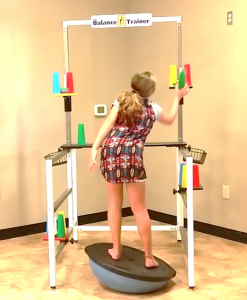
Non-verbal marker noted while on ADL Balance Trainer
We know, as therapists, that we need to challenge patients with exercises to help them get better. What we don’t know is exactly what the definition of “challenge” means when it comes to exercising balance. A recent study by Farlie et. al. (2015) looked at what patients say when training balance, and how these comments can provide insight in to intensity. When presented with challenging balance tasks (standing feet together, pick up pen from floor, walk backwards, jump, stand on toes, or tandem stand with eyes closed), patients offered the following comments:
- “Now this is a different story”
- “Ooh that will be hard”
- “Not so secure with that one.”
- “Oh no, can’t do it”
- “Sorry, I just lost my footing doing that one”
Patients also displayed a delay in task performance with medium- and hard-balance tasks. No delay was noted with easy tasks, however, a 3-second delay was recorded with medium-level tasks and a 6-second delay with hard ones.
Additionally, when facing medium and hard balancing tasks, patients displayed the following non-verbal responses:
- Postural reactions: Ankle, hip, stepping, and/or reaching strategies. Swaying, wobbling, moving, and flaring arms are indicators of a loss of steadiness and an attempt to regain balance.
- Bracing: Making a fist or holding the arms, legs, or torso stiff indicated a loss of balance.
Look for the above verbal and non-verbal expressions patients offer when presented with challenging balance tasks to help determine whether or not your balance exercises are effective. If you do not see any of these “tells,” then your balance intensity might be too easy. The downside is that your clinical outcomes will be not be where you or your patients want, if balance intensity is too easy.
